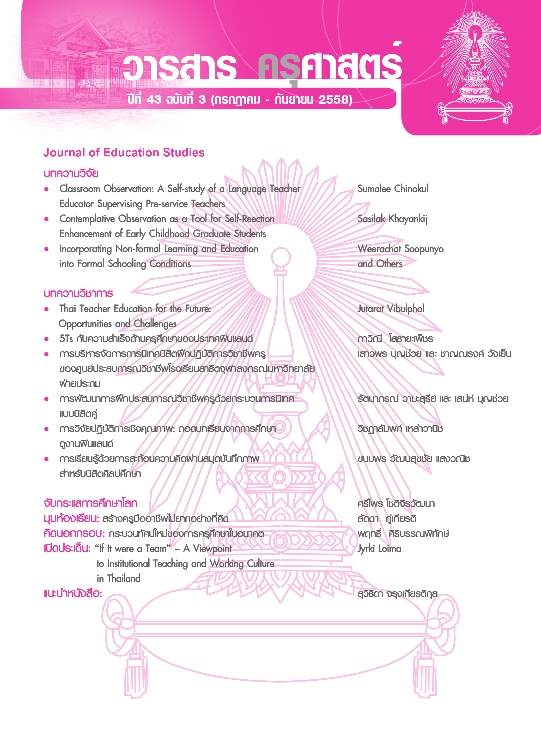Learning through Reflection in Sketchbook Journals for Art Education Students
Keywords:
Art Education, Integrated Learning, Sketchbook journals, Reflectiive WritingAbstract
A sketchbook journal is an important tool for self-study. Using a sketchbook journal is not only mainly for communicating by sketching but also for writing keywords or topics of thinking as well. Reflective writing is also one strategy for self-directed learning for practice and develops both teachers and students. This is integrated with open mindedness, responsibility and investigating the assumption of believing and the result of teaching methods. Reflective writing is a tool assisting in individual learning to know and understand oneûs self. Art education is pedagogical, integrating education and art. To encourage art education students, reflective thinking can be used via sketchbook journals. This strategy assists art students usually practicing self-directed learning by reflecting the students thinking through the sketching, drawing, and pasting of some materials, etc. The purpose of this article is related to the important theories of sketchbook journals, reflective writing and ideas for using tools for the content of philosophy and theory of art education. The case study of art education students in Thailand found that most students pay attention to jotting content more than sketching or drawing. Even if they received the handout of the lecture, there is little reflective thinking. Most students experience problems of drowsiness even though there are many activities for learning. Jotting in the sketchbook journal and reflective writing in the class is unfinished. Meanwhile, some students gain benefits from using sketchbook journals and reflective writing, and then attempt to use this strategy with other subjects including personal journals.
สมุดบันทึกภาพเป็นเครื่องมือสำคัญชิ้นหนึ่งในการเรียนรู้ด้วยตนเอง การจดบันทึกภาพด้วยสมุดบันทึกภาพนอกจากจะมีการใช้ภาพเป็นหลักแล้ว ยังมีการเขียนเกี่ยวกับคำสำคัญสั้นๆหรือประเด็นทางความคิดต่างๆด้วยเช่นกัน การสะท้อนความคิดเป็นวิธีการเรียนรู้ด้วยตนเองอย่างหนึ่งที่มีความสำคัญต่อการฝึกและพัฒนานิสิตครู เนื่องจากเป็นการบูรณาการทัศนคติด้านการเปิดรับฟังความคิดเห็น ความรับผิดชอบและตรวจสอบสมมุติฐานเกี่ยวกับความเชื่อ รวมถึงผลการสอนด้วยวิธีการต่างๆ เพื่อช่วยให้ผู้เรียนเกิดการเรียนรู้ด้วยตนเอง รู้จักและเข้าใจตนเองได้เป็นอย่างดี ศิลปศึกษาเป็นศาสตร์ที่บูรณาการระหว่างการศึกษาและศิลปะ การส่งเสริมให้นิสิตศิลปศึกษาสะท้อนความคิดผ่านสมุดบันทึกภาพจะช่วยให้นิสิตศิลปศึกษาฝึกการเรียนรู้ด้วยตนเองด้านการสะท้อนความคิดเป็นภาพและการเขียนอย่างสม่ำเสมอ วัตถุประสงค์ของบทความนี้จึงนำเสนอถึงความสำคัญของสมุดบันทึกภาพ การเขียนสะท้อนความคิดและแนวคิดของการนำไปใช้ในการเรียนรู้ในเนื้อหาที่เกี่ยวข้องกับปรัชญา ทฤษฎี แนวคิดด้านต่างๆ ซึ่งในกรณีศึกษาของการนำไปใช้กับนิสิตศิลปศึกษาในประเทศไทยพบว่า นิสิตส่วนใหญ่ให้ความสำคัญกับการจดบันทึกเนื้อหามากกว่าการวาดภาพ แม้ว่าจะได้รับเอกสารประกอบการสอนในรายวิชา มีการสะท้อนความคิดของตนเองสั้นๆ สำหรับปัญหาและอุปสรรคส่วนใหญ่ในการเรียน คือ ความง่วงแม้ว่ารายวิชาจะมีกิจกรรมที่หลากหลาย นิสิตมีความเห็นว่าไม่สามารถจดบันทึกให้เสร็จได้ทันภายในเวลาเรียน ขณะที่นิสิตบางส่วนเห็นความสำคัญและสนใจที่จะนำสมุดบันทึกภาพและการเขียนสะท้อนความคิดไปใช้ในรายวิชาอื่น รวมถึงการจดบันทึกเรื่องราวของตนเองในชีวิตประจำวันด้วย




